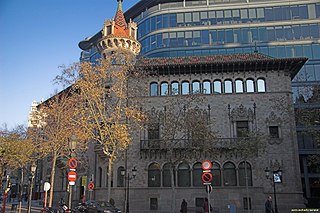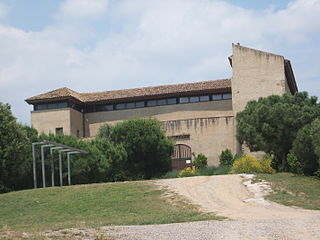
The Museu Nacional d'Art de Catalunya, abbreviated as MNAC, is a museum of Catalan visual art located in Barcelona, Catalonia, Spain. Situated on Montjuïc hill at the end of Avinguda de la Reina Maria Cristina, near Pl Espanya, the museum is especially notable for its outstanding collection of romanesque church paintings, and for Catalan art and design from the late 19th and early 20th centuries, including modernisme and noucentisme. The museum is housed in the Palau Nacional, a huge, Italian-style building dating to 1929. The Palau Nacional, which has housed the Museu d'Art de Catalunya since 1934, was declared a national museum in 1990 under the Museums Law passed by the Catalan Government. That same year, a thorough renovation process was launched to refurbish the site, based on plans drawn up by the architects Gae Aulenti and Enric Steegmann, who were later joined in the undertaking by Josep Benedito. The Oval Hall was reopened for the 1992 Summer Olympic Games, and the various collections were installed and opened over the period from 1995 to 2004. The museum was officially inaugurated on 16 December 2004. It is one of the largest museums in Spain.

Santa Coloma de Gramenet, informally simply known as Santa Coloma, and formerly as Gramenet de Besòs between 1936 and 1939, is a municipality in Barcelonès county, in Catalonia, Spain. It is situated on the south-east side of the coastal range, with the Puig Castellar (299 m) as its highest point, on the left bank of the Besòs river: the municipalities of Sant Adrià de Besòs and Badalona separate it from the coast. It is the ninth most populated city in Catalonia.

The Barcelona Provincial Council Local Museum Network, also known as Catalonia’s Biggest Museum, is a tool for support and collaboration from and for the museums of the province, which makes available to municipalities a series of services and actions aimed at improving, through the provision of direct services and research into viable formulas for supramunicipal cooperation, the management, conservation and dissemination of heritage and the museum facilities of the towns of Barcelona province. It is managed from the Cultural Heritage Office, which in turn depends on the Department of Knowledge and New Technologies of Barcelona Provincial Council.

The Cardadeu Tomàs Balvey Museum-Archive, in Cardedeu, Vallès Oriental, is organised around the legacy of Tomàs Balvey i Bas (1865–1954), the last of a line of apothecaries in Cardedeu. The theme of the museum is based on the pharmacy and its pharmacist, focusing on the world of illness, remedies and health. The Museum-Archive is part of the Barcelona Provincial Council Local Museum Network and of the Catalan Pharmacy Museum Network.

The Can Tinturé Museum, in Esplugues de Llobregat, is located in a house built at the end of the 19th century by architect Claudi Duran i Ventosa, and is the first monographic sample tile museum in Spain. The Can Tinturé Museum also manages the museum at the Pujol i Bausis factory, La Rajoleta, which was a point of reference in the production of Catalan industrial tiles, especially during the highpoint of Art Nouveau. The Museum is part of the Barcelona Provincial Council Local Museum Network and of the territorial system of the Science and Technology Museum of Catalonia.

The Gavà Museum and the Gavà Mines Archaeological Park, founded in 1978, comprises two facilities: the Gavà Museum and the Gavà Mines Archaeological Park. It is part of the Barcelona Provincial Council Local Museum Network.

The Granollers Museum is a heterogeneous collection comprising archaeology, decorative arts, ethnography, numismatics and ancient, modern and contemporary art. The Museum, which is part of the Barcelona Provincial Council Local Museum Network, coordinates and supports a major part of the archaeological excavations taking place in the region of El Vallès Oriental, while promoting awareness and protection of local cultural heritage. In addition, the Museum manages L'Adoberia, the medieval Granollers historic interpretation centre.

The L’Hospitalet Museum, in L'Hospitalet de Llobregat (Barcelonès), is a municipally owned cultural facility that aims to disseminate and conserve the cultural heritage and resources of L'Hospitalet. The museum was opened in 1972 in Casa Espanya, built in the 16th century, and is part of the Barcelona Provincial Council Local Museum Network.

The Museu Comarcal de Manresa is a pluridisciplinary museum created on 2 September 1896 in Manresa and currently located in the old elementary school of Sant Ignasi. It is part of the Barcelona Provincial Council Local Museum Network.

The L’Enrajolada Santacana House-Museum, in Martorell, is one of the oldest museums in Catalonia. It was founded in 1876 by Francesc Santacana i Campmany (1810-1896) and then taken over by his grandson, Francesc Santacana i Romeu (1883-1936). It is located in an old private residence with four floors and a garden, which belonged to the Santacana family. L'Enrajolada is part of the Barcelona Provincial Council Local Museum Network.
The Vicenç Ros Municipal Museum, in Martorell, occupies one of the sections of an old Capuchin convent dating back to the 17th century and is part of Barcelona Provincial Council Local Museum Network. Opened in 1945, the museum came to be thanks to Vicenç Ros i Batllevell (1883–1970), who donated his large ceramics collection. Over the years, the museum has organised its collection into different categories, which it has expanded: ethnology, art, archaeology, architecture and archives.

The El Masnou Municipal Nautical Museum is a municipally owned museum, the backbone of which is El Masnou’s relationship with the sea. It is part of the Barcelona Provincial Council Local Museum Network, the Maritime Museums of the Catalan Coast Network and the Mediterranean Maritime Museum Association.

The Mataró Museum is a museum in Mataró, in El Maresme, with a central office in Can Serra, a fortified Renaissance building dating back to 1565. The museum, which is part of the Barcelona Provincial Council Local Museum Network, also manages the different local heritage centres, such as:

The El Prat Museum, in El Prat de Llobregat, Catalonia, was created in 1962 as part of an initiative of the town council to recover the town’s historic and natural heritage. It is located in Balcells Tower, a building from the mid-19th century that was used for farming and as a summer residence, and is part of the Barcelona Provincial Council Local Museum Network. In the next few years the El Prat Museum will relocate to a new building currently under construction.

The aim of Premià de Dalt Museum is to compile, study and disseminate the rich heritage of Premià de Dalt (Maresme) to be found in archaeological, archival, architectural and urban elements. The museum, which is part of the Barcelona Provincial Council Local Museum Network, is based on a project to create a museum that is open, fun and participative.

The Rubí Municipal Museum or El Castell-Urban Ecomuseum is a museum in Rubí, Catalonia, Spain.

The Sant Boi de Llobregat Museum conserves and carries out research into the cultural heritage and historic memory of the town of Sant Boi de Llobregat in Catalonia, Spain. The main museum collections are those of Iberian, Roman and Medieval archaeological remains unearthed during the different excavations carried out in the town and different ethnographic sources. The museum houses the permanent exhibitions Sant Boi. Temps i espai and Rafael Casanova i el seu temps, as well as different temporary exhibitions. Founded in 1998, the museum is part of the Barcelona Provincial Council Local Museum Network and is housed in several buildings: Can Barraquer, Can Torrents, the Roman thermal baths and Benviure tower.
The Terrassa Museum is a museum entity which encompasses all the municipally owned museums in the city of Terrassa. It belongs to the History Museum and Monument Network of Catalonia and the Barcelona Provincial Council Local Museum Network.

The purpose of the Vilassar de Dalt Archive-Museum is the conservation and dissemination of the archaeological, architectural, historical, natural and cultural heritage of Vilassar de Dalt and its environment. Located in the Can Banús farmhouse, records for which date back as far as the 14th century, its main collection can be broken down into four categories: archaeology, textiles, history and the historic archive.

The Archaeology Museum of Catalonia in Girona is one of the five venues of the Archaeology Museum of Catalonia, located in the Sant Pere de Galligants Benedictine abbey of Girona since its foundation in 1857. It contains materials found during archaeological excavations at various sites in the province of Girona, dating from prehistory to the Middle Ages.


















